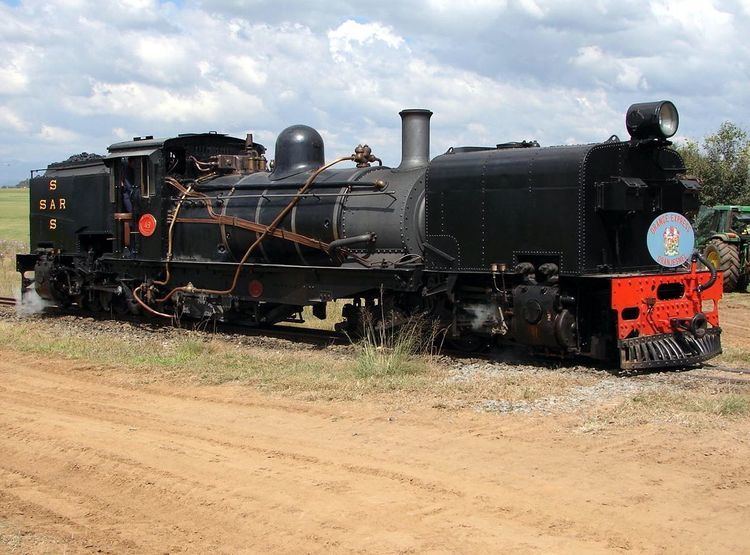Power type Steam Build date 1927-1928 | ||
 | ||
Designer Hannoversche Maschinenbau AG Builder Hannoversche Maschinenbau AG Serial number 10549-10551, 10598-10599, 10629-10635 | ||
The South African Railways Class NG G13 2-6-2+2-6-2 of 1927 was a narrow gauge articulated steam locomotive.
Contents
Between 1927 and 1929, the South African Railways placed twelve Class NG G13 Garratt articulated steam locomotives with a 2-6-2+2-6-2 Double Prairie type wheel arrangement in service on the Langkloof and Alfred County Railway narrow gauge lines.
Manufacturer
In 1927, Hannoversche Maschinenbau AG (Hanomag), in consultation with the South African Railways (SAR), designed a locomotive which was to become the standard 2 feet (610 millimetres) narrow gauge Garratt locomotive in South Africa for the next forty years. It was greatly improved from the Class NG G11, with trailing wheels added to each engine unit, outside bar frames instead of plate frames, round-topped fireboxes instead of Belpaire fireboxes, and larger dimensions in most respects except the grate area.
The initial order was for three Class NG G13 locomotives, numbered in the range from NG58 to NG60, which were delivered and placed in service in November 1927. These locomotives were superheated and sported an extremely compact arrangement of Walschaerts valve gear and outside bar frames. The leading wheels were arranged as conventional pony trucks, while the inner carrying wheels were built to the Gölsdorf system, which allowed the axle some lateral movement.
Performance trials of the Class NG G13 proved it to be both powerful and free steaming, despite having a smaller grate area than the predecessor Class NG G11. This resulted in an immediate order for another two locomotives, numbers NG49 and NG50, and even before these were delivered, another seven, numbered in the range from NG77 to NG83. The second and third orders were both delivered in 1928, with the third order locomotives entering service during January 1929.
Service
The introduction of articulated locomotives on the 2 ft (610 mm) narrow gauge branches gave this gauge a new lease of life and made it easier to withstand the agitation from some quarters to convert these branches to Cape gauge. Apart from appreciable economies in working, they enabled train loads and the carrying capacity of the narrow gauge lines to be virtually doubled, without the need to strengthen track and bridges.
Natal
The first five locomotives, numbers NG49, NG50 and NG58 to NG60, were used almost exclusively on the narrow gauge lines in Natal. Some of these routes had curves of 45 metres (148 feet) radius and gradients of up to 3 in 100 (3%), but the Garratts were well suited to hauling the diverse freight traffic of pulpwood, sugar cane and bananas.
One of these lines, the 122 kilometres (76 miles) branchline from Port Shepstone to Paddock via Izotsha, was eventually privatised as the Port Shepstone and Alfred County Railway (ACR) after the SAR ceased operations there in 1986. The ACR conducted both freight and tourist passenger operations, with the tourist train becoming known as the Banana Express.
Cape Province
The third order of seven locomotives, numbers NG77 to NG83, initially all went to the Avontuur line, where most of them remained for their entire service lives. In 1965, numbers NG77 and NG78 were exchanged for two Class NG G11 locomotives, numbers NG54 and NG55, from the Natal system. The Avontuur locomotives ended their service lives working out of Loerie, either hauling limestone trains to Van Stadens or doing duty on the Patensie branchline.
The 283 kilometres (176 miles) Avontuur line stretches from Port Elizabeth to Avontuur through the Langkloof. The narrow gauge track enabled the trains to pick up fruit virtually directly from the Langkloof fruit farms and ship it directly, without reloading, to the ripening warehouses, distributors and ships at Port Elizabeth. The route became known as the Apple Express after the main crop it transported. The line also carried pulpwood, as well as limestone to supply the cement factories which were located on the route.
Retirement
When the lower section of the Avontuur line was dieselised upon the arrival of the Class 91-000 diesel-electric locomotives in 1973, the Class NG G13 locomotives were all withdrawn from service. Beginning at about the same time, the Natal locomotives were also progressively withdrawn from service.
Preservation
Since withdrawal from SAR service, some locomotives were sold into private hands, while others ended up in various degrees of preservation, ranging across the spectrum from operational to plinthing to total abandonment. One known ex SAR Class NG G13 Garratt, no. NG49 serving at the Sandstone Estates near Ficksburg, is being kept in excellent running order. Two were plinthed, no. NG80 at Joubertina station and no. NG81 at Patensie station. No. NG50 is also restored and has been operational from 15 November 2015, at the Hempstead and Northern Railroad in Hempstead, Texas.
The last known locations of all the Class NG G13 locomotives are shown in the table.
Locations as at c. March 2017
